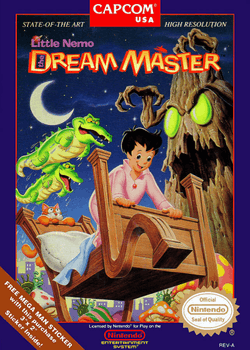Little Nemo: The Dream Master
| Little Nemo: The Dream Master | |
|---|---|
|
North American boxart | |
| Developer(s) | Capcom |
| Publisher(s) | Capcom |
| Producer(s) | Tokuro Fujiwara |
| Designer(s) | Tatsuya Minami |
| Composer(s) | Junko Tamiya |
| Platform(s) | NES/Famicom |
| Release date(s) | |
| Genre(s) | Platformer |
| Mode(s) | Single-player |
Little Nemo: The Dream Master (known as Pajama Hero Nemo (パジャマヒーロー NEMO Pajama Hīrō Nīmō) in Japan) is a platform game released on the NES in 1990 by Capcom. It is based on the Japanese animated film, Little Nemo: Adventures in Slumberland from Tokyo Movie Shinsha, which itself is based on the comic strip Little Nemo in Slumberland by Winsor McCay. The game's music was composed by Junko Tamiya, credited in the game as "Gonzou".
The game revolves around a young boy in his own surreal dreams as he journeys to Slumberland. Nemo can ride certain animals such as a frog, a gorilla, or a mole, by feeding them candy. Each animal has its own skills needed to complete each level. The purpose of the game is to travel to the Nightmare land to rescue Morpheus, the king of Slumberland, from the clutches of the evil Nightmare King.
Gameplay
In Little Nemo: The Dream Master, the player controls Nemo as he proceeds through side-scrolling, 2D levels. In each level, Nemo must collect a specific number of keys, which are generally scattered throughout the rather large levels. The number of keys needed to beat each level is not indicated to the player until reaching the exit at the end of the level, which has a corresponding number of locks. The player must proceed through each level, typically left to right but also up and down, searching for keys.
Throughout each level the player encounters several animals, which, after being fed, will allow Nemo to use their powers. Using the powers of some animals is necessary, while others simply make things a little easier. The animal's life-bars often differ from Nemo, with some animals possessing extra health bars. Such abilities are vital, as many challenging obstacles exist throughout the game, and enemies are virtually almost infinite. As such, Little Nemo is generally regarded as a highly difficult game.

